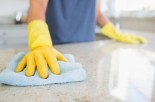Certified Green Building Expert, Lisa Beres, is back on Naturally Savvy to share some of the simple steps you can take to do more than just clean, but rather detox your kitchen.
Start with Your Sink
Did you know that your kitchen sink may harbor more germs than your toilet bowl? The typical kitchen sink can hold 100,000 bacteria per square cm, and E. coli and salmonella can live on the sides of the sink.
To make the bacteria and grime disappear, you can use a mixture of baking soda and natural dish soap. Mix together until it forms a paste, then scour the sink. This is a great alternative to the typical abrasive cleaners which contain harsh chemicals.
Vinegar is also a great option.
Clear the Air
Formaldehyde, which is a VOC and carcinogen, is often contained in the pressed wood products within your kitchen (e.g., your cabinet system). To absorb the formaldehyde and other VOCs, you can actually use plants. The purple waffle plant, English ivy, asparagus fern, and purple heart plant are just a few options for cleaning up the air in your kitchen. Just make sure you have one plant for every 100 square feet to effectively clean the air.
Avoid Toxic Plastics
All plastics have some sort of estrogenic activity, but the worst offenders are numbers 3, 6, and 7 (as identified on the bottom of the container with the resin identification code). While it's impossible to eliminate all plastics, your goal should be to use stainless steel and glass whenever you can.
Control Odors
You breathe 20,000 breaths a day... that's a lot of air. Your kitchen traps odors from things like last night's dinner, smoke, pets, mildew, and cleaning supplies. To help mitigate these odors, use your vented exhaust fan, which will reduce moisture (to prevent mold and mildew) and vent cooking particulates. You can also put an odor control filter in your heating and cooling system.
Avoid Pesticides in Produce
Make sure you're purchasing the "Clean 15," which are the produce lowest in pesticide residue (as identified by the Environmental Working Group) and avoid the "Dirty Dozen." To wash off pesticide residue, soak produce for 10 minutes in water and vinegar. This will remove any lingering pesticides and that waxy cover as well.
Listen in as Lisa joins hosts Andrea and Lisa to share these simple tips for detoxifying your kitchen.

 Lisa and Ron Beres are Certified Green Building Professionals, Building Biologists and published authors of several books including Just GREEN It! and the children's book, My Body My House. In addition to testing the health of homes, their consulting business includes celebrities and Fortune 500's. They are award winning television media experts and have appeared on The Rachael Ray Show, The Suzanne Show, The Doctors, Fox & Friends, The Today Show with Matt Lauer, NBC’s Nightly News with Brian Williams, Discovery’s Greenovate and Chelsea Lately on E!
Lisa and Ron Beres are Certified Green Building Professionals, Building Biologists and published authors of several books including Just GREEN It! and the children's book, My Body My House. In addition to testing the health of homes, their consulting business includes celebrities and Fortune 500's. They are award winning television media experts and have appeared on The Rachael Ray Show, The Suzanne Show, The Doctors, Fox & Friends, The Today Show with Matt Lauer, NBC’s Nightly News with Brian Williams, Discovery’s Greenovate and Chelsea Lately on E!